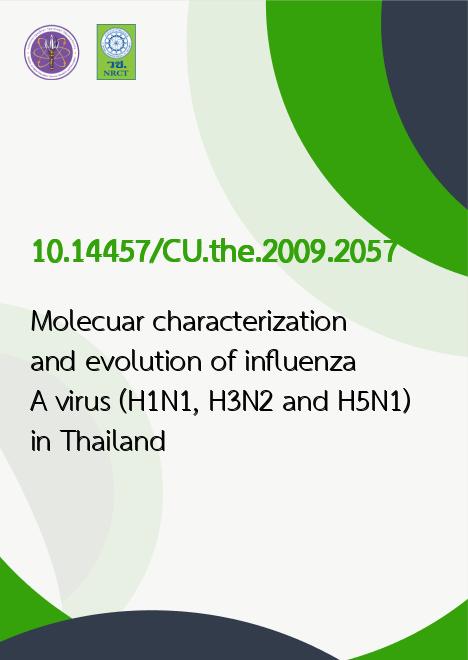
|
Molecuar characterization and evolution of influenza A virus (H1N1, H3N2 and H5N1) in Thailand |
|---|---|
| รหัสดีโอไอ | |
| Title | Molecuar characterization and evolution of influenza A virus (H1N1, H3N2 and H5N1) in Thailand |
| Creator | Kamol Suwannakarn |
| Contributor | Yong Poovorawan, Alongkorn Amonsin |
| Publisher | Chulalongkorn University |
| Publication Year | 2552 |
| Keyword | Influenza, Avian influenza |
| Abstract | Influenza virus infection is a major public health problem of global concerns. In this study, human influenza (H1N1 and H3N2) and avian influenza (H5N1) viruses isolated in Thailand were studied. This study consists of 3 parts. Firstly, a specific and sensitive one-step multiplex real-time RT-PCR was developed in two assays for typing influenza A and influenza B virus and subtyping H1, H3 and H5 influenza A virus. These assays have high sensitivity, high specificity and high accuracy. Second, the complete genome of seasonal influenza A virus from Thailand in 2006 to 2008 subtypes H1N1 (n=5) and H3N2 (n=13) were selected for molecular evolution analyses. Phylogenetic analysis of the HA and NA genes formed seasonal clusters and closely related to the WHO recommended vaccine strains in each season. Antigenic sites characterization, Nlinked glycosylation pattern in surface gene and selection pressure were studied. Moreover, H5N1 isolated in Thailand between 2004 and 2008 were also studied on the molecular evolution. Phylogenetic analysis among Thai isolates indicated that clade 1 viruses in Thailand consist of three distinct lineages: CUK2-like, PC168-like, and PC170- like viruses. In 2008, viruses reassorted from these two lineages, PC168-like and PC170- like viruses, were initially isolated in the lower northern provinces of Thailand and subsequently spread to the upper central part of Thailand. On the other hand, CUK2-like viruses were still detected around the lower northern and the upper central part of Thailand. The substitution rate among clade 1 viruses in Thailand was low. Third, H5N1 viral quasispecies in tiger were detected at position 627 in PB2 viral protein by using clonal sequencing. Quasispecies between lysine and glutamic acid at this position just found only one tiger in trachea organ. The viral genome quasispecies perform by high resolution genomic sequencing needs further study. |
| URL Website | cuir.car.chula.ac.th |